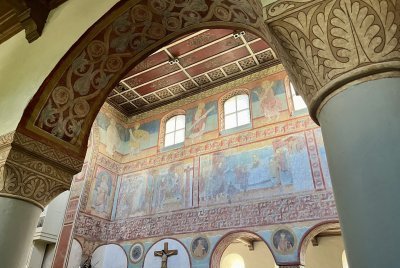
This site is rather hard to grasp: The undoubtedly enormous religious, political and artistic importance of this monastery is comprehensible only in traces by the three churches left on the island of Reichenau. I start in the west (with the least interesting IMHO): St. Peter and Paul is heavily baroquified and only the apsis behind the altar shows interesting frescoes. They are bit far and dark and therefore difficult to see and appreciate. The main church, the Basilica Minor St. Maria und Markus, is an impressive structure but it has little charm: While the quire is heavily baroquified the nave is rather empty (probably since the reformation): But the church has a remarkable treasury with several ancient (pre-baroque!) treasures: a must. The jewel of the island is clearly the church of St. George with is Ottonian frescoes from around 1000AD. They have nothing to be compared with north of the alps and are well worth the trip from anywhere. They can only be visited by tours which are offered quite regularly, at least in summertime. Like many frescoes they are quite well preserved because they were painted over during the reformation. The presentation of the churches has been improved in recent years and now there is a little museum next to each of the churches to give more background.
Core zone: It contains the complete island what makes in a way sense since, at the time, the whole island was part of the monastery and much of its land used for wine and other agriculture. On the other hand this doesn't make any sense since most of the island is now built over by simple, very unremarkable post war buildings, mostly one family houses. There seems hardly any settlement plan and it lacks any special architectural character. It is really surprising it was inscribed this way (when we see how in other sites much more attractive towns are meticulously excluded from the core zone) and I think the core zone should be changed to include only the churches and their surrounding buildings. There rest, which is potentially interesting archeologically, would protected well enough as a buffer zone.
The main reason I write this review now has a specific reason: At the moment the monastery has its 1300 year anniversary and this is celebrated with a big exposition at the archeological museum in the nearby city of Konstanz/Constance. It includes many precious artworks, especially some wonderful ivory reliefs, that were made or used in Reichenau monastery but have now been recollected from around the world for this exposition. While I liked the ivory reliefs the best the real stars are the illustrated manuscripts for which the monastery was famous and several of them are included in the UNESCO Memory of the World. So if you want to get a better picture of the importance of this monastery this is probably the chance of our lifetime.
If you are in Konstanz do miss the opportunity to spend a day of so in this town which is at least as interesting as the monastery island: This remarkable historic town was hardly destroyed and is therefore one of the better preserved in Germany. And it was for four very important years the absolute centre of Europe for the Council of Constance, an event so important that you almost wonder why Germany never tried to make a nomination about it, especially since most of the original important buildings are well preserved. Among the many stories from this council I find especially the one around the Czech reformer Jan Hus fascinating who was invited to Constance with clear assurance for his safety but then he was burnt nonetheless as a heretic. There are many places you can visit linked to Hus' story among them former dominican monastery where he was imprisoned, now an upscale hotel with a good restaurant right a the lake. Also the cathedral of Our Lady is splendid and not to miss.
More on
Comments
No comments yet.
